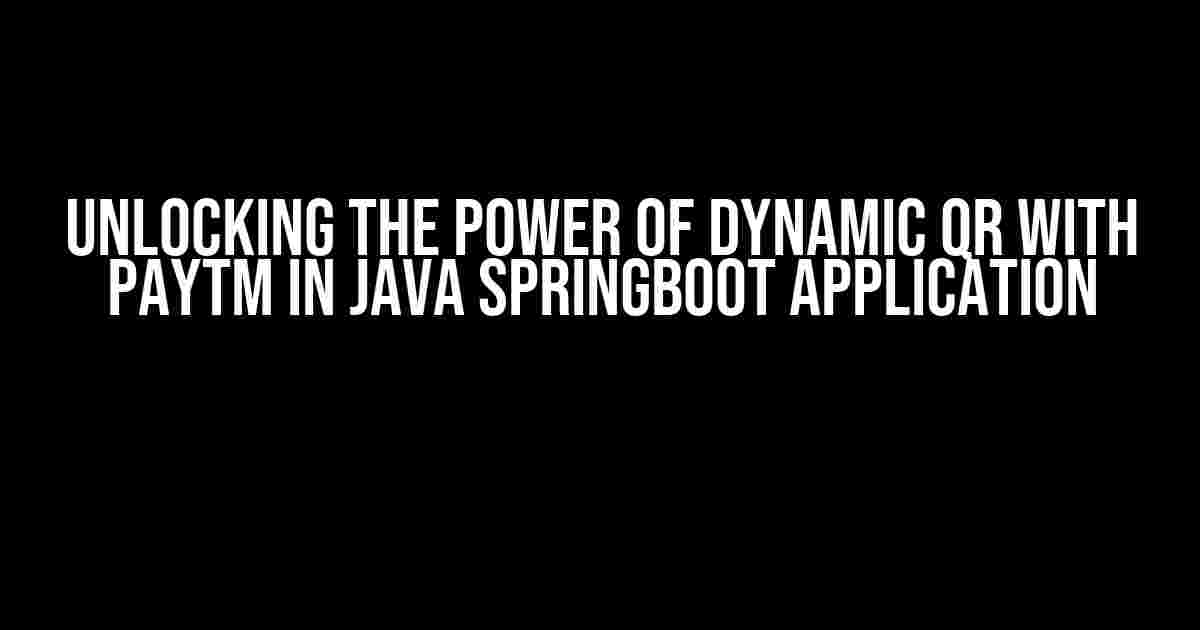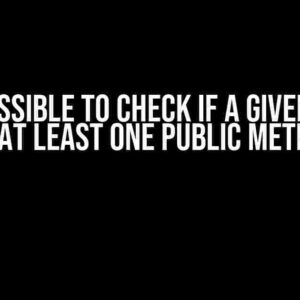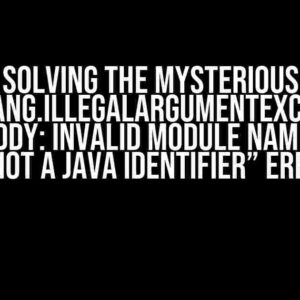Are you tired of dealing with static QR codes that limit your payment processing capabilities? Do you want to take your payment system to the next level with the power of dynamic QR codes? Look no further! In this comprehensive article, we’ll show you how to integrate dynamic QR with PayTM in a Java Springboot application.
What is Dynamic QR?
A dynamic QR code is a type of QR code that can be updated in real-time, allowing you to change the content of the QR code without having to recreate it. This is in contrast to static QR codes, which are fixed and cannot be changed once generated. Dynamic QR codes are particularly useful in payment processing, as they enable you to generate unique QR codes for each transaction, making it more secure and efficient.
Why Choose PayTM?
PayTM is one of the leading payment gateways in India, offering a wide range of payment processing solutions for businesses of all sizes. By integrating PayTM with your Java Springboot application, you can provide your customers with a seamless payment experience. With PayTM, you can process transactions, manage orders, and track payments with ease.
Prerequisites
To get started with integrating dynamic QR with PayTM in a Java Springboot application, you’ll need the following:
- A Java Springboot project set up with the necessary dependencies
- A PayTM merchant account with API credentials
- A QR code generator library (we’ll be using Google’s ZXing library)
- A Java IDE (such as Eclipse or IntelliJ)
Step 1: Set up PayTM API Credentials
The first step is to set up your PayTM API credentials. Log in to your PayTM merchant account and navigate to the API settings section. Create a new API key and secret key, and note them down. You’ll need these credentials to authenticate with the PayTM API.
PayTM API Credentials
| API Key | YOUR_API_KEY_HERE |
|---|---|
| Secret Key | YOUR_SECRET_KEY_HERE |
Step 2: Configure PayTM API in Springboot Application
Next, you’ll need to configure the PayTM API in your Springboot application. Create a new configuration file (e.g. `application.properties`) and add the following properties:
paytm.api.key=YOUR_API_KEY_HERE paytm.api.secret=YOUR_SECRET_KEY_HERE paytm.api.url=https://secure.paytm.in/order/flow
In your Springboot application, create a new configuration class to load the PayTM API credentials:
@Configuration
public class PaytmConfig {
@Value("${paytm.api.key}")
private String apiKey;
@Value("${paytm.api.secret}")
private String apiSecret;
@Value("${paytm.api.url}")
private String apiURL;
@Bean
public PaytmAPI paytmAPI() {
return new PaytmAPI(apiKey, apiSecret, apiURL);
}
}
Step 3: Generate Dynamic QR Code
Now, let’s generate a dynamic QR code using the ZXing library. Create a new service class (e.g. `QRCodeService`) to generate the QR code:
@Service
public class QRCodeService {
@Autowired
private PaytmAPI paytmAPI;
public String generateQRCode(Long orderId, Double amount) {
// Generate a unique transaction token
String txnToken = paytmAPI.initiateTransaction(orderId, amount);
// Create a QR code data matrix
String qrCodeData = "https://secure.paytm.in/order/flow?ORDER_ID=" + orderId + "&TXN_TOKEN=" + txnToken;
// Generate the QR code using ZXing
QRCodeWriter qrCodeWriter = new QRCodeWriter();
byte[] qrCodeBytes = qrCodeWriter.write(qrCodeData, BarcodeFormat.QR_CODE, 200, 200);
// Convert the QR code bytes to a Base64-encoded string
String qrCodeString = Base64.getEncoder().encodeToString(qrCodeBytes);
return qrCodeString;
}
}
Step 4: Integrate Dynamic QR with PayTM in Springboot Controller
Finally, let’s integrate the dynamic QR code with PayTM in a Springboot controller. Create a new controller class (e.g. `PaymentController`) to handle payment requests:
@RestController
@RequestMapping("/payments")
public class PaymentController {
@Autowired
private QRCodeService qrCodeService;
@PostMapping("/{orderId}")
public String makePayment(@PathVariable Long orderId, @RequestParam Double amount) {
// Generate the dynamic QR code
String qrCodeString = qrCodeService.generateQRCode(orderId, amount);
// Return the QR code as a Base64-encoded string
return qrCodeString;
}
}
Conclusion
And that’s it! You’ve successfully integrated dynamic QR with PayTM in a Java Springboot application. With this implementation, you can generate unique QR codes for each transaction, making it more secure and efficient. Remember to customize the QR code data matrix to fit your specific payment processing requirements.
Troubleshooting Tips
If you encounter any issues during implementation, here are some troubleshooting tips:
- Check your PayTM API credentials and ensure they are correct
- Verify that your PayTM API key and secret key are correctly configured in your Springboot application
- Ensure that your QR code data matrix is correctly formatted and encoded
- Check the ZXing library version and ensure it is compatible with your Java version
Next Steps
Now that you’ve integrated dynamic QR with PayTM, you can take your payment system to the next level by:
- Implementing payment tracking and notifications
- Integrating with other payment gateways
- Enhancing security with additional authentication layers
By following this comprehensive guide, you’ve unlocked the power of dynamic QR with PayTM in a Java Springboot application. Take your payment system to new heights and provide your customers with a seamless payment experience!
Frequently Asked Question
Are you integrating PayTM with Dynamic QR code in your Java Springboot application and have some questions in mind? Don’t worry, we’ve got you covered! Check out these frequently asked questions and their answers below.
What is a Dynamic QR code, and how does it work with PayTM in a Java Springboot application?
A Dynamic QR code is a type of QR code that can be edited and updated in real-time, allowing for more flexible and dynamic payment processing. In a Java Springboot application, you can integrate Dynamic QR codes with PayTM by generating a unique QR code for each transaction, which redirects the user to the PayTM payment gateway. This eliminates the need for manual payment inputs, making the payment process faster and more convenient.
How do I generate a Dynamic QR code in my Java Springboot application for PayTM payments?
To generate a Dynamic QR code in your Java Springboot application, you’ll need to use a QR code generation library such as Google’s ZXing or QRGen. You can create a REST API that accepts payment details as input and returns a Dynamic QR code as output. Then, you can integrate this API with your PayTM payment gateway to enable seamless payment processing.
What are the benefits of using Dynamic QR codes with PayTM in my Java Springboot application?
Using Dynamic QR codes with PayTM in your Java Springboot application offers several benefits, including faster payment processing, reduced errors, and enhanced user experience. Dynamic QR codes also provide an additional layer of security, as they can be encrypted and decrypted in real-time, making it more difficult for hackers to intercept and manipulate payment information.
Can I customize the design and layout of my Dynamic QR code for PayTM payments in my Java Springboot application?
Yes, you can customize the design and layout of your Dynamic QR code to match your brand identity and application theme. Most QR code generation libraries offer customization options, such as logo embedding, color schemes, and design templates. You can also use CSS and HTML to further customize the appearance of your Dynamic QR code.
How do I handle errors and exceptions when integrating Dynamic QR codes with PayTM in my Java Springboot application?
To handle errors and exceptions when integrating Dynamic QR codes with PayTM, you should implement robust error handling mechanisms, such as try-catch blocks and error logging. You should also validate user input and payment details to prevent errors and exceptions. Additionally, consider implementing retries and fallback mechanisms to ensure that payment processing is not interrupted in case of errors or exceptions.





![How to Check if a Field is Annotated by a Lombok Annotation at Runtime? [duplicate] How to Check if a Field is Annotated by a Lombok Annotation at Runtime? [duplicate]](https://triphena.hkhazo.biz.id/wp-content/uploads/sites/49/2024/07/how-to-check-if-a-field-is-annotated-by-a-lombok-annotation-at-runtime-duplicate-with-text-300x300.jpg)